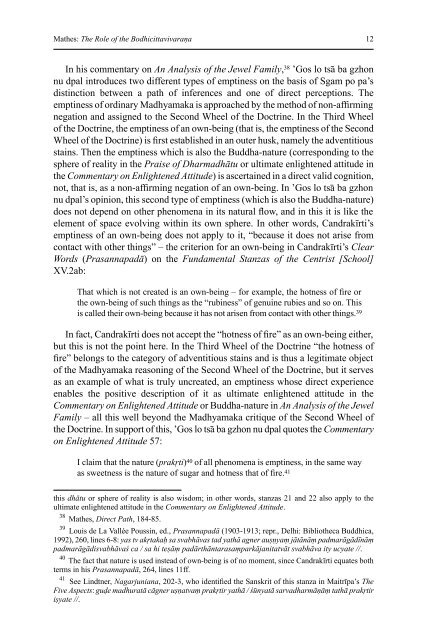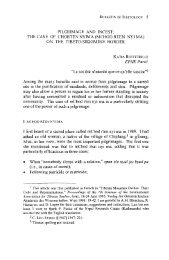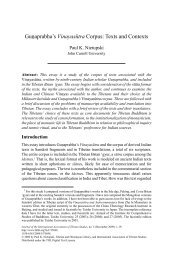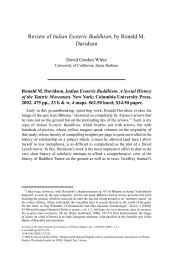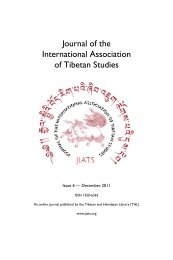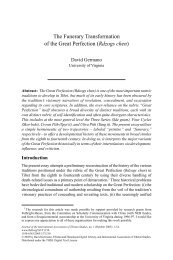The Role of the Bodhicittavivaraṇa in the Mahāmudrā Tradition of ...
The Role of the Bodhicittavivaraṇa in the Mahāmudrā Tradition of ...
The Role of the Bodhicittavivaraṇa in the Mahāmudrā Tradition of ...
Create successful ePaper yourself
Turn your PDF publications into a flip-book with our unique Google optimized e-Paper software.
Ma<strong>the</strong>s: <strong>The</strong> <strong>Role</strong> <strong>of</strong> <strong>the</strong> <strong>Bodhicittavivaraṇa</strong><br />
In his commentary on An Analysis <strong>of</strong> <strong>the</strong> Jewel Family, 38 ’Gos lo tsā ba gzhon<br />
nu dpal <strong>in</strong>troduces two different types <strong>of</strong> empt<strong>in</strong>ess on <strong>the</strong> basis <strong>of</strong> Sgam po pa’s<br />
dist<strong>in</strong>ction between a path <strong>of</strong> <strong>in</strong>ferences and one <strong>of</strong> direct perceptions. <strong>The</strong><br />
empt<strong>in</strong>ess <strong>of</strong> ord<strong>in</strong>ary Madhyamaka is approached by <strong>the</strong> method <strong>of</strong> non-affirm<strong>in</strong>g<br />
negation and assigned to <strong>the</strong> Second Wheel <strong>of</strong> <strong>the</strong> Doctr<strong>in</strong>e. In <strong>the</strong> Third Wheel<br />
<strong>of</strong> <strong>the</strong> Doctr<strong>in</strong>e, <strong>the</strong> empt<strong>in</strong>ess <strong>of</strong> an own-be<strong>in</strong>g (that is, <strong>the</strong> empt<strong>in</strong>ess <strong>of</strong> <strong>the</strong> Second<br />
Wheel <strong>of</strong> <strong>the</strong> Doctr<strong>in</strong>e) is first established <strong>in</strong> an outer husk, namely <strong>the</strong> adventitious<br />
sta<strong>in</strong>s. <strong>The</strong>n <strong>the</strong> empt<strong>in</strong>ess which is also <strong>the</strong> Buddha-nature (correspond<strong>in</strong>g to <strong>the</strong><br />
sphere <strong>of</strong> reality <strong>in</strong> <strong>the</strong> Praise <strong>of</strong> Dharmadhātu or ultimate enlightened attitude <strong>in</strong><br />
<strong>the</strong> Commentary on Enlightened Attitude) is ascerta<strong>in</strong>ed <strong>in</strong> a direct valid cognition,<br />
not, that is, as a non-affirm<strong>in</strong>g negation <strong>of</strong> an own-be<strong>in</strong>g. In ’Gos lo tsā ba gzhon<br />
nu dpal’s op<strong>in</strong>ion, this second type <strong>of</strong> empt<strong>in</strong>ess (which is also <strong>the</strong> Buddha-nature)<br />
does not depend on o<strong>the</strong>r phenomena <strong>in</strong> its natural flow, and <strong>in</strong> this it is like <strong>the</strong><br />
element <strong>of</strong> space evolv<strong>in</strong>g with<strong>in</strong> its own sphere. In o<strong>the</strong>r words, Candrakīrti’s<br />
empt<strong>in</strong>ess <strong>of</strong> an own-be<strong>in</strong>g does not apply to it, “because it does not arise from<br />
contact with o<strong>the</strong>r th<strong>in</strong>gs” – <strong>the</strong> criterion for an own-be<strong>in</strong>g <strong>in</strong> Candrakīrti’s Clear<br />
Words (Prasannapadā) on <strong>the</strong> Fundamental Stanzas <strong>of</strong> <strong>the</strong> Centrist [School]<br />
XV.2ab:<br />
That which is not created is an own-be<strong>in</strong>g – for example, <strong>the</strong> hotness <strong>of</strong> fire or<br />
<strong>the</strong> own-be<strong>in</strong>g <strong>of</strong> such th<strong>in</strong>gs as <strong>the</strong> “rub<strong>in</strong>ess” <strong>of</strong> genu<strong>in</strong>e rubies and so on. This<br />
is called <strong>the</strong>ir own-be<strong>in</strong>g because it has not arisen from contact with o<strong>the</strong>r th<strong>in</strong>gs. 39<br />
In fact, Candrakīrti does not accept <strong>the</strong> “hotness <strong>of</strong> fire” as an own-be<strong>in</strong>g ei<strong>the</strong>r,<br />
but this is not <strong>the</strong> po<strong>in</strong>t here. In <strong>the</strong> Third Wheel <strong>of</strong> <strong>the</strong> Doctr<strong>in</strong>e “<strong>the</strong> hotness <strong>of</strong><br />
fire” belongs to <strong>the</strong> category <strong>of</strong> adventitious sta<strong>in</strong>s and is thus a legitimate object<br />
<strong>of</strong> <strong>the</strong> Madhyamaka reason<strong>in</strong>g <strong>of</strong> <strong>the</strong> Second Wheel <strong>of</strong> <strong>the</strong> Doctr<strong>in</strong>e, but it serves<br />
as an example <strong>of</strong> what is truly uncreated, an empt<strong>in</strong>ess whose direct experience<br />
enables <strong>the</strong> positive description <strong>of</strong> it as ultimate enlightened attitude <strong>in</strong> <strong>the</strong><br />
Commentary on Enlightened Attitude or Buddha-nature <strong>in</strong> An Analysis <strong>of</strong> <strong>the</strong> Jewel<br />
Family – all this well beyond <strong>the</strong> Madhyamaka critique <strong>of</strong> <strong>the</strong> Second Wheel <strong>of</strong><br />
<strong>the</strong> Doctr<strong>in</strong>e. In support <strong>of</strong> this, ’Gos lo tsā ba gzhon nu dpal quotes <strong>the</strong> Commentary<br />
on Enlightened Attitude 57:<br />
I claim that <strong>the</strong> nature (prakṛti) 40 <strong>of</strong> all phenomena is empt<strong>in</strong>ess, <strong>in</strong> <strong>the</strong> same way<br />
as sweetness is <strong>the</strong> nature <strong>of</strong> sugar and hotness that <strong>of</strong> fire. 41<br />
this dhātu or sphere <strong>of</strong> reality is also wisdom; <strong>in</strong> o<strong>the</strong>r words, stanzas 21 and 22 also apply to <strong>the</strong><br />
ultimate enlightened attitude <strong>in</strong> <strong>the</strong> Commentary on Enlightened Attitude.<br />
38 Ma<strong>the</strong>s, Direct Path, 184-85.<br />
39 Louis de La Vallée Pouss<strong>in</strong>, ed., Prasannapadā (1903-1913; repr., Delhi: Biblio<strong>the</strong>ca Buddhica,<br />
1992), 260, l<strong>in</strong>es 6-8: yas tv akṛtakaḥ sa svabhāvas tad yathā agner auṣṇyaṃ jātānāṃ padmarāgādīnāṃ<br />
padmarāgādisvabhāvaś ca / sa hi teṣāṃ padārthāntarasaṃparkājanitatvāt svabhāva ity ucyate //.<br />
40 <strong>The</strong> fact that nature is used <strong>in</strong>stead <strong>of</strong> own-be<strong>in</strong>g is <strong>of</strong> no moment, s<strong>in</strong>ce Candrakīrti equates both<br />
terms <strong>in</strong> his Prasannapadā, 264, l<strong>in</strong>es 11ff.<br />
41 See L<strong>in</strong>dtner, Nagarjuniana, 202-3, who identified <strong>the</strong> Sanskrit <strong>of</strong> this stanza <strong>in</strong> Maitrīpa’s <strong>The</strong><br />
Five Aspects: guḍe madhuratā cāgner uṣṇatvaṃ prakṛtir yathā / śūnyatā sarvadharmāṇāṃ tathā prakṛtir<br />
iṣyate //.<br />
12


